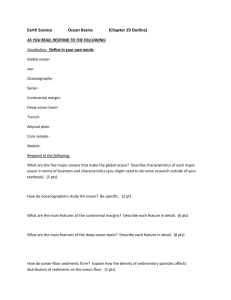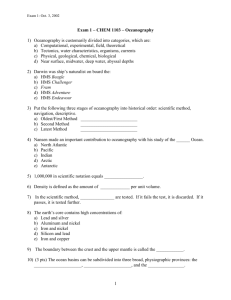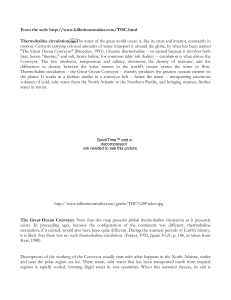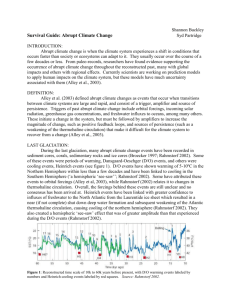THORNTON-ATMS-211-Homework-7-ANSWER
advertisement
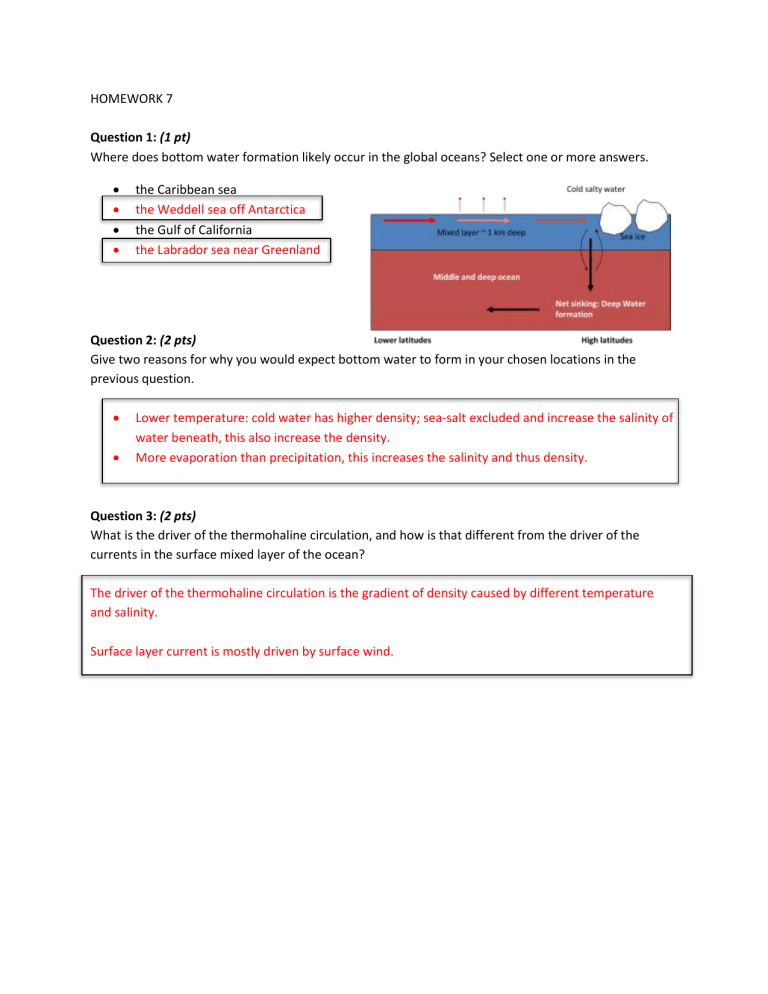
HOMEWORK 7 Question 1: (1 pt) Where does bottom water formation likely occur in the global oceans? Select one or more answers. the Caribbean sea the Weddell sea off Antarctica the Gulf of California the Labrador sea near Greenland Question 2: (2 pts) Give two reasons for why you would expect bottom water to form in your chosen locations in the previous question. Lower temperature: cold water has higher density; sea-salt excluded and increase the salinity of water beneath, this also increase the density. More evaporation than precipitation, this increases the salinity and thus density. Question 3: (2 pts) What is the driver of the thermohaline circulation, and how is that different from the driver of the currents in the surface mixed layer of the ocean? The driver of the thermohaline circulation is the gradient of density caused by different temperature and salinity. Surface layer current is mostly driven by surface wind. Question 4: (2 pts) If local warming caused sea ice to melt in the locations in Question 1, what change in oceanic circulation might result? Describe the effects of this change in circulation, on the amount of sea-ice melt. [Hint: think about the heat transport by ocean currents]. Sea-ice melting keeps diluting the ocean water, which suppress the bottom water formation. This also slows the poleward heat transport to higher latitude. Effects: Decrease the temperature at high latitudes. Lower/stop the sea-ice melting. Negative feedback Question 5: (1 pt) What is the approximate time scale of the thermohaline circulation to mix the surface and deep oceans. a) b) c) d) 10 years 100 years 1000 years 100,000 years Question 6: (5 pts) Given the following diagram of the carbon cycle is from the IPCC AR4 (2007), which shows estimates of carbon reservoirs and fluxes for preindustrial (black) and anthropogenic (red) contributions to the cycle. Is the marine biota reservoir of carbon in equilibrium? What is the lifetime of carbon in this reservoir in years? In days? Inflow: 50 Outflow: 39 + 11 = 50 Yes, in equilibrium Lifetime: 3 / 50 = 0.06 year = 22 days Question 7: (5 pts) Using the figure given in Question 6, is the intermediate and deep ocean reservoir of carbon in balance? If not, what is the flux changer per year? Is it a sink or source for the intermediate and deep ocean reservoirs? Inflow: 90.2 + 11 + 1.6 = 101.2 + 1.6 Outflow: 101 + 0.2 = 101.2 In balance in preindustrial time, but not in present day. Net inflow = 1.6 Serves as a sink (ocean acidification) Question 8: (5 pts) Humans ingest organic carbon and respire CO2 into the atmosphere. With the growth of human populations, will increased CO2 exhalation from humans contribute to increasing atmospheric CO2? Question 9: (5 pts) A consequence of global warming is the melting of the polar ice caps. This melting decreases deep-water formation. In the context of the carbon cycle, would this effect result in a negative or positive feedback to global warming? Explain. (Hint: think about the air-sea exchange of CO2 and the biological pump). T increase -> melting of the polar ice caps increase > slow down thermohaline circulation -> less deep water exposure -> more CO2 uptake -> Lower CO2 concentration -> T decrease Negative feedback However, if CO2 is really high (even higher than deep water), opposite thing happens.


